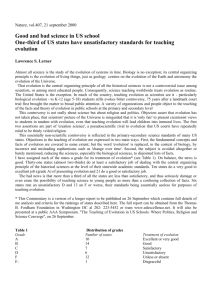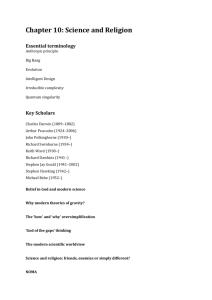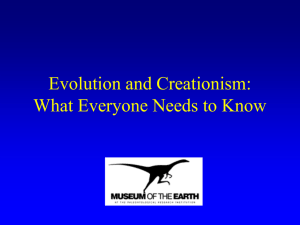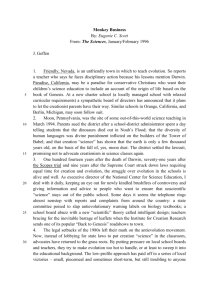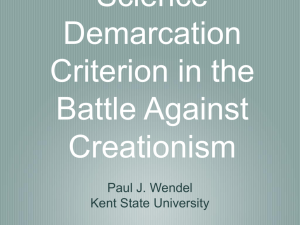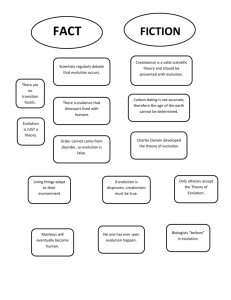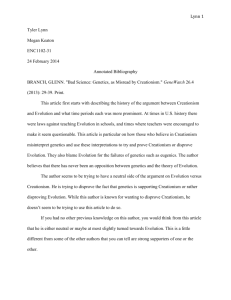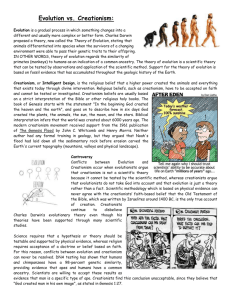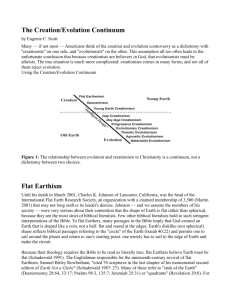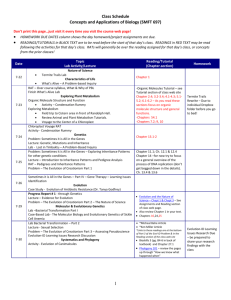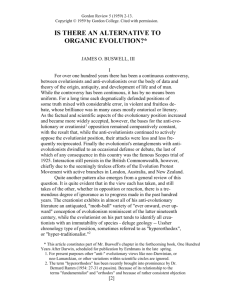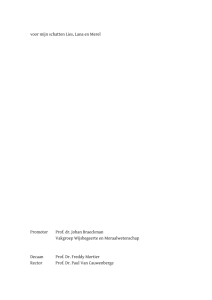Introduction - University of Kentucky
advertisement
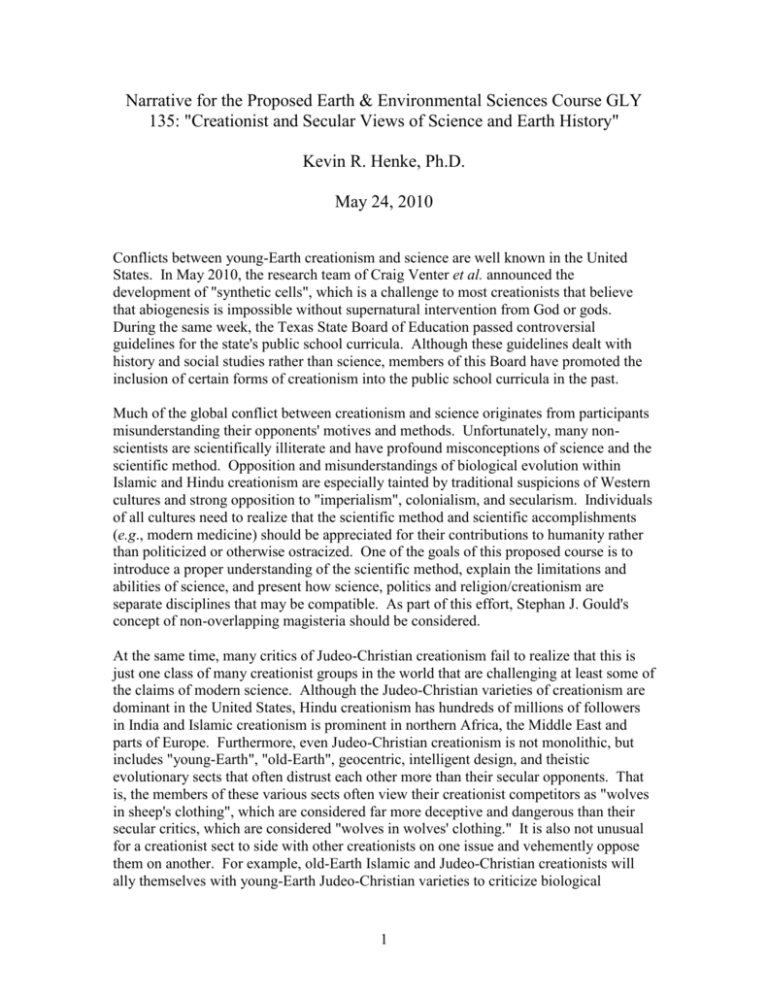
Narrative for the Proposed Earth & Environmental Sciences Course GLY 135: "Creationist and Secular Views of Science and Earth History" Kevin R. Henke, Ph.D. May 24, 2010 Conflicts between young-Earth creationism and science are well known in the United States. In May 2010, the research team of Craig Venter et al. announced the development of "synthetic cells", which is a challenge to most creationists that believe that abiogenesis is impossible without supernatural intervention from God or gods. During the same week, the Texas State Board of Education passed controversial guidelines for the state's public school curricula. Although these guidelines dealt with history and social studies rather than science, members of this Board have promoted the inclusion of certain forms of creationism into the public school curricula in the past. Much of the global conflict between creationism and science originates from participants misunderstanding their opponents' motives and methods. Unfortunately, many nonscientists are scientifically illiterate and have profound misconceptions of science and the scientific method. Opposition and misunderstandings of biological evolution within Islamic and Hindu creationism are especially tainted by traditional suspicions of Western cultures and strong opposition to "imperialism", colonialism, and secularism. Individuals of all cultures need to realize that the scientific method and scientific accomplishments (e.g., modern medicine) should be appreciated for their contributions to humanity rather than politicized or otherwise ostracized. One of the goals of this proposed course is to introduce a proper understanding of the scientific method, explain the limitations and abilities of science, and present how science, politics and religion/creationism are separate disciplines that may be compatible. As part of this effort, Stephan J. Gould's concept of non-overlapping magisteria should be considered. At the same time, many critics of Judeo-Christian creationism fail to realize that this is just one class of many creationist groups in the world that are challenging at least some of the claims of modern science. Although the Judeo-Christian varieties of creationism are dominant in the United States, Hindu creationism has hundreds of millions of followers in India and Islamic creationism is prominent in northern Africa, the Middle East and parts of Europe. Furthermore, even Judeo-Christian creationism is not monolithic, but includes "young-Earth", "old-Earth", geocentric, intelligent design, and theistic evolutionary sects that often distrust each other more than their secular opponents. That is, the members of these various sects often view their creationist competitors as "wolves in sheep's clothing", which are considered far more deceptive and dangerous than their secular critics, which are considered "wolves in wolves' clothing." It is also not unusual for a creationist sect to side with other creationists on one issue and vehemently oppose them on another. For example, old-Earth Islamic and Judeo-Christian creationists will ally themselves with young-Earth Judeo-Christian varieties to criticize biological 1 evolution and yet bitterly disagree with the young-Earth creationists and side with geochronologists on the effectiveness of radiometric dating methods. Therefore, interactions between various creationist sects are very complex and range from strong alliances to open hostility depending on the particular issue. This proposed course will emphasize the diversity and complexity of the various creationist groups. The course will also demonstrate that, depending on the issue, creationists are not necessarily a threat to scientific research, but may be powerful allies. Unlike most other courses in the Department of Earth & Environmental Sciences (EES), this proposed course best corresponds with the Global Dynamics template under Citizenship (IV) of the General Education curriculum. The course will concentrate on how the major forms of creationism dynamically interact with each other and science. Instead of concentrating on local or state controversies in the USA, the perspective of this proposed course is to evaluate how local and regional interactions between science and creationism in a given culture can have far reaching effects on scientific research, science education, legislation, and civil order widely outside of that culture. For example, the multilingual and colorful literature of Turkish Islamic creationist Harun Yahya (a.k.a., Adnan Oktar) is having a profound effect on science education in northern Africa, the Middle East and in Islamic communities throughout Europe. Although natural selection and other key aspects of biological evolution were actually expressed by Muslim thinkers, such as Al-Jahiz, as early as the 8th century CE, skepticism for evolution is now even greater in Turkey and many other Islamic countries than in the USA. On the other hand, biological evolution, although theistic, is more widely accepted among the Shia clerics in Iran than liberal Turkey. Some University of Kentucky graduates will be working as physicians, translators, medical researchers, geologists, and other professionals outside the US. This course will help them to avoid making premature and false assumptions about local views on science and religion, and assist University of Kentucky graduates in better understanding what the citizens of their host nations actually think about their scientific or other work. This proposed course will address the Course Learning outcomes of the Global Dynamics template by: Discussing the origins and diversity of the major forms of creationism around the world and how they interact with each other and transcultural science. Describing how local support for Hindu, Islamic, Judeo-Christian and other creationist organizations may have far-reaching effects on science, science education, and legislation in other nations. Appreciating the important global contributions of geology to our societies, including a comprehensive understanding of the Earth's history. Showing how the major forms of creationism have evolved over the centuries and how they have responded favorably and unfavorably to scientific discoveries. 2 Providing examples of how conflicts between creationist and anti-creationist groups often involve struggles for power and influence in government, education and culture. The course will heavily rely on assignments and discussion groups within the recitation. Each student will perform a class research project. With guidance from the instructor and teaching assistant(s), the student will select a research topic on a significant transnational issue or problem associated with how a particular form of creationism interacts with scientific research, different cultures or science education. As part of the project, the student should offer solutions to any problems and explain how the issue or problem has widespread and potentially global implications. The project will consist of a term paper that will be posted on the class webpage and an oral presentation in the recitation. The results of these projects will be used to represent the course in its assessment for the General Education program. The recitation will also consist of a number of "hands on" laboratory exercises and experiments. One of the assignments will be a learning experience that will utilize some of the fundamental geologic principles established by William "Strata" Smith (17691839) and Nicolas Steno (1638-1686). First, small groups of students will perform hydraulic experiments involving the aqueous sorting of particles by size, shape and density on the EES stream table. Based on their observations, each student will write an essay predicting how fossils should be distributed in the geologic record according to the Judeo-Christian-Islamic Flood geology model and the actualistic ("uniformitarian") model of modern geology. Next, the students will compare the vertical distributions of invertebrate (corals, ammonites, trilobites, etc.) fossil assemblages from two or three widely separated localities on the Earth. The two to three localities will be selected from a list of locations that are known to have undisturbed fossiliferous sedimentary rocks from a large number of geologic periods (such as, the Jiuxi Basin of China, the Carpathian Basin of Poland, the Bogotá Basin of Colombia, the Williston Basin of North Dakota, USA, etc.). The assignment will include actual fossils of representative genera from the EES collection. The students will also look for any biological evolutionary trends among the fossil phyla, classes, orders, etc. Another task will consist of laterally comparing the fossil assemblages of the localities and correlating them. After correlation, the students will then be asked to explain the lateral and vertical fossil distributions at the localities using the Judeo-Christian-Islamic creationist Flood and modern geology models. Finally, each student will compare and contrast the effectiveness of the two models to explain the fossil distributions. This exercise should provide the students with "hands on" discoveries and learning experiences that would be a far more effective and profound than what they could obtain from just reading opposing viewpoints from the geology and creationist Flood literature. 3
